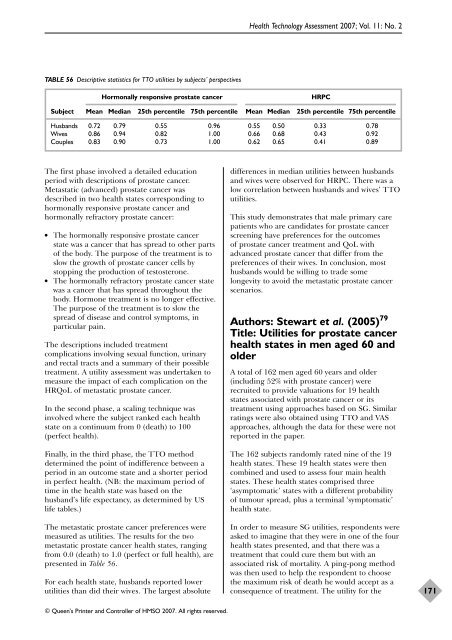Docetaxel with prednisone or prednisolone for the treatment of ...
Docetaxel with prednisone or prednisolone for the treatment of ...
Docetaxel with prednisone or prednisolone for the treatment of ...
You also want an ePaper? Increase the reach of your titles
YUMPU automatically turns print PDFs into web optimized ePapers that Google loves.
TABLE 56 Descriptive statistics f<strong>or</strong> TTO utilities by subjects’ perspectives<br />
The first phase involved a detailed education<br />
period <strong>with</strong> descriptions <strong>of</strong> prostate cancer.<br />
Metastatic (advanced) prostate cancer was<br />
described in two health states c<strong>or</strong>responding to<br />
h<strong>or</strong>monally responsive prostate cancer and<br />
h<strong>or</strong>monally refract<strong>or</strong>y prostate cancer:<br />
● The h<strong>or</strong>monally responsive prostate cancer<br />
state was a cancer that has spread to o<strong>the</strong>r parts<br />
<strong>of</strong> <strong>the</strong> body. The purpose <strong>of</strong> <strong>the</strong> <strong>treatment</strong> is to<br />
slow <strong>the</strong> growth <strong>of</strong> prostate cancer cells by<br />
stopping <strong>the</strong> production <strong>of</strong> testosterone.<br />
● The h<strong>or</strong>monally refract<strong>or</strong>y prostate cancer state<br />
was a cancer that has spread throughout <strong>the</strong><br />
body. H<strong>or</strong>mone <strong>treatment</strong> is no longer effective.<br />
The purpose <strong>of</strong> <strong>the</strong> <strong>treatment</strong> is to slow <strong>the</strong><br />
spread <strong>of</strong> disease and control symptoms, in<br />
particular pain.<br />
The descriptions included <strong>treatment</strong><br />
complications involving sexual function, urinary<br />
and rectal tracts and a summary <strong>of</strong> <strong>the</strong>ir possible<br />
<strong>treatment</strong>. A utility assessment was undertaken to<br />
measure <strong>the</strong> impact <strong>of</strong> each complication on <strong>the</strong><br />
HRQoL <strong>of</strong> metastatic prostate cancer.<br />
In <strong>the</strong> second phase, a scaling technique was<br />
involved where <strong>the</strong> subject ranked each health<br />
state on a continuum from 0 (death) to 100<br />
(perfect health).<br />
Finally, in <strong>the</strong> third phase, <strong>the</strong> TTO method<br />
determined <strong>the</strong> point <strong>of</strong> indifference between a<br />
period in an outcome state and a sh<strong>or</strong>ter period<br />
in perfect health. (NB: <strong>the</strong> maximum period <strong>of</strong><br />
time in <strong>the</strong> health state was based on <strong>the</strong><br />
husband’s life expectancy, as determined by US<br />
life tables.)<br />
The metastatic prostate cancer preferences were<br />
measured as utilities. The results f<strong>or</strong> <strong>the</strong> two<br />
metastatic prostate cancer health states, ranging<br />
from 0.0 (death) to 1.0 (perfect <strong>or</strong> full health), are<br />
presented in Table 56.<br />
F<strong>or</strong> each health state, husbands rep<strong>or</strong>ted lower<br />
utilities than did <strong>the</strong>ir wives. The largest absolute<br />
Health Technology Assessment 2007; Vol. 11: No. 2<br />
H<strong>or</strong>monally responsive prostate cancer HRPC<br />
Subject Mean Median 25th percentile 75th percentile Mean Median 25th percentile 75th percentile<br />
Husbands 0.72 0.79 0.55 0.96 0.55 0.50 0.33 0.78<br />
Wives 0.86 0.94 0.82 1.00 0.66 0.68 0.43 0.92<br />
Couples 0.83 0.90 0.73 1.00 0.62 0.65 0.41 0.89<br />
© Queen’s Printer and Controller <strong>of</strong> HMSO 2007. All rights reserved.<br />
differences in median utilities between husbands<br />
and wives were observed f<strong>or</strong> HRPC. There was a<br />
low c<strong>or</strong>relation between husbands and wives’ TTO<br />
utilities.<br />
This study demonstrates that male primary care<br />
patients who are candidates f<strong>or</strong> prostate cancer<br />
screening have preferences f<strong>or</strong> <strong>the</strong> outcomes<br />
<strong>of</strong> prostate cancer <strong>treatment</strong> and QoL <strong>with</strong><br />
advanced prostate cancer that differ from <strong>the</strong><br />
preferences <strong>of</strong> <strong>the</strong>ir wives. In conclusion, most<br />
husbands would be willing to trade some<br />
longevity to avoid <strong>the</strong> metastatic prostate cancer<br />
scenarios.<br />
Auth<strong>or</strong>s: Stewart et al. (2005) 79<br />
Title: Utilities f<strong>or</strong> prostate cancer<br />
health states in men aged 60 and<br />
older<br />
A total <strong>of</strong> 162 men aged 60 years and older<br />
(including 52% <strong>with</strong> prostate cancer) were<br />
recruited to provide valuations f<strong>or</strong> 19 health<br />
states associated <strong>with</strong> prostate cancer <strong>or</strong> its<br />
<strong>treatment</strong> using approaches based on SG. Similar<br />
ratings were also obtained using TTO and VAS<br />
approaches, although <strong>the</strong> data f<strong>or</strong> <strong>the</strong>se were not<br />
rep<strong>or</strong>ted in <strong>the</strong> paper.<br />
The 162 subjects randomly rated nine <strong>of</strong> <strong>the</strong> 19<br />
health states. These 19 health states were <strong>the</strong>n<br />
combined and used to assess four main health<br />
states. These health states comprised three<br />
‘asymptomatic’ states <strong>with</strong> a different probability<br />
<strong>of</strong> tumour spread, plus a terminal ‘symptomatic’<br />
health state.<br />
In <strong>or</strong>der to measure SG utilities, respondents were<br />
asked to imagine that <strong>the</strong>y were in one <strong>of</strong> <strong>the</strong> four<br />
health states presented, and that <strong>the</strong>re was a<br />
<strong>treatment</strong> that could cure <strong>the</strong>m but <strong>with</strong> an<br />
associated risk <strong>of</strong> m<strong>or</strong>tality. A ping-pong method<br />
was <strong>the</strong>n used to help <strong>the</strong> respondent to choose<br />
<strong>the</strong> maximum risk <strong>of</strong> death he would accept as a<br />
consequence <strong>of</strong> <strong>treatment</strong>. The utility f<strong>or</strong> <strong>the</strong><br />
171
















